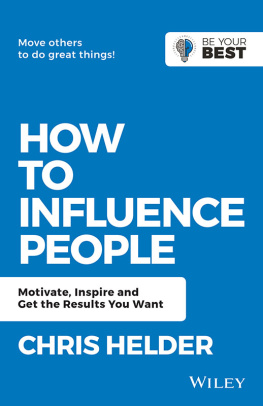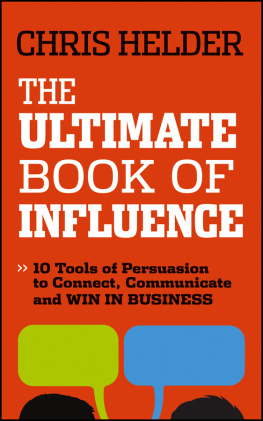Copyright 2011 by Michael V. Pantalon, PhD
All rights reserved. Except as permitted under the U.S. Copyright Act of 1976, no part of this publication may be reproduced, distributed, or transmitted in any form or by any means, or stored in a database or retrieval system, without the prior written permission of the publisher.
Little, Brown and Company
Hachette Book Group
237 Park Avenue
New York, NY 10017
Visit our website at www.HachetteBookGroup.com.
www.twitter.com/littlebrown.
First eBook Edition: May 2011
Little, Brown and Company is a division of Hachette Book Group, Inc. The Little, Brown name and logo are trademarks of Hachette Book Group, Inc.
The publisher is not responsible for websites (or their content) that are not owned by the publisher.
ISBN: 978-0-316-13465-1
To my family
my wife, Marianne Sharsky Pantalon, PhD, and my sons, Matthew and Nicholas. You inspire, motivate, and influence me in all the best possible ways every day. I love you.
To everyone who continues to believe, no matter what, that we might always be able to influence ourselves and others for good.
Follow that will and that way which experience confirms to be your own.
Carl Jung
Introduction:
Instant Influence in Action
T he General Electric executives stared back at me, skeptical, unsettled. I couldnt blame them: these human resources specialists were all comfortable with their own procedures for dealing with difficult employees, but now they were being required to learn my approach as well. This training session was mandatory, and I could read opposition in their tightly folded arms and in the grim expressions on their faces. I might have to be here, their body language said, but I sure dont have to like it.
If I didnt quickly grab their attention, they might not be convinced that my technique for dealing with unmotivated workers was worth their while. I had them for only a few hours, and teaching them how to use this new approach would take every bit of that time. But if I spent all morning talking and they didnt participate, what good would that do?
Well, my method is called Instant Influence, and one of its most exciting features is that it can work almost immediately, often in seven minutes or less. What if I spent seven minutes motivating these executives to listen to my presentation?
WHAT IS INSTANT INFLUENCE?
As a psychologist and researcher at Yale, Ive spent many years investigating ways to move people from feeling resistant to being motivated. I began by working with a technique developed by William R. Miller and Stephen Rollnick known as motivational interviewing, Over the past fifteen years, Ive devised a groundbreaking six-step version thats so fast and so effective that it actually results in instant influence.
Instant Influence is the only scientifically proven method for motivating people in seven minutes or less. It gets people to take action by encouraging them to find their own reasons for doing what you are asking of them. Just by asking someone six simple questions, you can inspire him to realize why he might want to take some kind of action: quit smoking, get to work on time, fill out his quarterly reports, or pay you back that twenty dollars he owes you. Instant Influence works on pretty much anything at all. You can also use this approach on yourself, to become more productive, stick to your diet, take up exercise, or accomplish anything else you may be struggling with. It works on people who know they want to change and are eager to get started, people who think they want to change but fear they cant, and people who think they dont want to change. It doesnt really matter who uses itInstant Influence just works.
The two greatest advantages of Instant Influence are that you can learn the technique quickly and see results almost immediately.treating them in the ER. In other words, the doctors had about seven minutes to influence semi-inebriated patients who didnt necessarily view themselves as needing help.
Seven minutes, resistant patients, and a hectic emergency room. What could possibly move people to change their lives under those circumstances? The answer is simple: their own reasons. People usually act for their own reasons, not someone elses reasons. If they do change a behavior because of something someone else has said, most of the time that change wont stick. The secret of Instant Influence is that it helps people discover their own reasons for doing something, even something they thought they didnt want to do.
You help people not by telling them why they should change but, rather, by asking them why they might want to change. Here are the six steps that will allow you to achieve Instant Influence:
Step 1: Why might you change? (Or to influence yourself, why might I change?)
Step 2: How ready are you to changeon a scale from 1 to 10, where 1 means not ready at all and 10 means totally ready?
Step 3: Why didnt you pick a lower number? (Or if the influencee picked 1, either ask the second question again, this time about a smaller step toward change, or ask, what would it take for that 1 to turn into a 2?)
Step 4: Imagine youve changed. What would the positive outcomes be?
Step 5: Why are those outcomes important to you?
Step 6: Whats the next step, if any?
The ER docs were so successful using my approach that they were able to achieve a nearly 50 percent reduction in drinking among their alcohol-involved patientsjust from seven-minute conversations. As a result, Instant Influence is now a standard part of care in emergency rooms and in major trauma units across the United States, and medical residents nationwide are required to learn it.
After I developed this technique, I went on to apply it in many other settings. Ive introduced Instant Influence to professionals at all levels, from middle managers, sales representatives, and human resource specialists to CEOs. Ive trained and coached key staff and executives at such companies as Bayer, Bristol-Myers Squibb, and General Electric, and at such training centers as the American Management Association and the Addiction Technology Transfer Center. Ive worked with Ivy League universities, including Yale, Harvard, and Brown; such major federal agencies as the National Institutes of Health and the US Department of Health and Human Services; such prominent medical centers as Yale-New Haven Hospital, Harvards McLean Hospital, and NY Langone Medical Center; and numerous state judicial branches and departments of probation and parole. Ive trained staff from prominent drug and alcohol rehab centers, including Hazelden, Betty Ford, and Crossroads at Antigua. Ive taught Instant Influence to health-care providers, social workers, psychologists, psychiatrists, and case managers for the homeless, as well as teachers and parents.
After more than fifteen years of training, research, and hands-on coaching experience, I know that Instant Influence can work on virtually anyone, from the most motivated CEO to the most resistant teenager.giving up cigarettes, and resolving problems in personal relationships.
LETTING PEOPLE CONVINCE THEMSELVES
Since people respond much better when they act for their own reasons rather than yours, we need to help them discover their reasons as soon as possible. However, if youre working with people who are resistant, as I was with the GE group, acknowledging that resistanceinstead of fighting itis a surprisingly effective way of getting them to be less defensive and more open.












